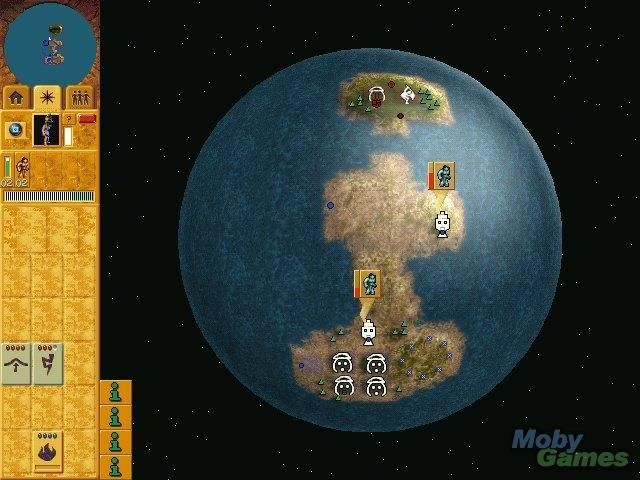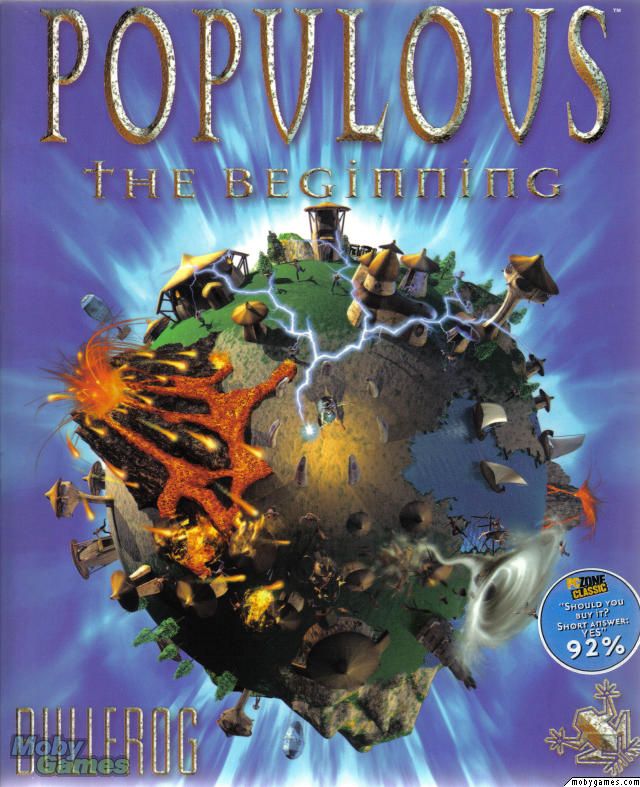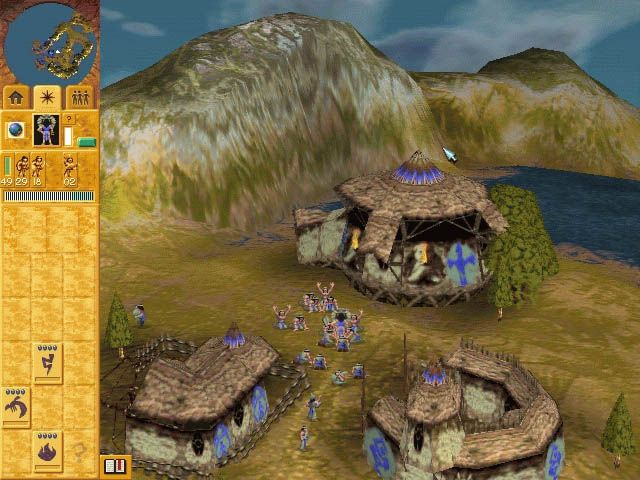
Populous: The Beginning is a strategy and god-style video game. It is the third entry in the Populous video game series, developed by Bullfrog Productions in 1998. The PC version of the game was released November 30, 1998 and a PlayStation version was later developed and released on April 2, 1999. Unlike earlier games in the series, which cast the player in the role of a god influencing loyal followers, The Beginning took a radical departure and placed the player in the role of a shaman, who directly leads her tribe against opponents. Throughout the twenty-five missions of the campaign, the player leads their tribe across a solar system, dominating enemy tribes and tapping new sources of magic, with the ultimate goal of the shaman attaining godhood herself.
Populous: The Beginning was the first entry in the series to use true 3D computer graphics; Bullfrog waited four years after Populous II so that the graphics technology could catch up to their vision for a new and different game in the series. The developers considered the addition of terrain deformation and manipulation, combined with "smart" villagers who automatically attended to tasks, to add an entirely new dimension to the series. The game's original title was Populous: The Third Coming before being changed prior to the beta release.
Populous: The Beginning plays very differently from earlier titles and received mixed reviews. Reviewers positively noted the excellent graphics, while complaints were directed at the artificial intelligence and the indecision in game design between being a real time strategy title and a god game. GamePro's Peter Olafson wrote that Populous: The Beginning was not a bad game, in fact a good one; "but it's a different game—one without a quintessential quality that defined Populous.
Gameplay

The game's three-dimensional graphics engine allows the player to zoom out to see the entire world.
Populous: The Beginning places the player in control of a female shaman and the tribe which follows her. Unlike the previous games in the series, The Beginning allows the player to directly control the action of followers, by ordering them to build structures or attack enemies. In the campaign, the player must fight the opposing Dakini, Chumara and Matak tribes for dominion over the solar system. Enemy tribes also have shamans, and on later levels all inhabit the same world. While the objective is almost always to eliminate all of the members of the other tribes, there are often specific ways this can be achieved. Sometimes the player must use magic spells gained from worship at special monuments such as stone heads or "Vaults of Knowledge"; in other cases, the player only needs to overwhelm the enemies with superior numbers. The game has no formal resource management; new units are created automatically at houses, and training new warriors costs nothing except mana. Only wood from trees is required to build new structures.
The game is played from a 3D third person perspective with the camera at a variable height and capable of rotating 360°, enabling the player to quickly move across the planet's terrain, which is actually a real projective plane rather than a usual sphere; on maps where there is no fog of war, players can see what opponents are doing at any time. Extensive support for 3D acceleration enables the player to view the game in 16-bit or 32-bit colour. The landscape and real-time structure building and follower movement are also shown.
A tornado cast by a shaman rips apart enemy buildings.
The player commands different types of followers, each of which has advantages and disadvantages in combat. The most basic unit is the Brave, which builds huts, towers, and military buildings. Braves are trained to become other units: tough melee Warriors; weak, long-range, Firewarriors; Priests, who convert enemy units and prevent enemy priests from converting friendly troops; and Spies, who perform espionage functions. Shamans are physically weaker than warriors, but can cast powerful spells and can be resurrected if killed. Some spells will disappear after use. Other spells can slowly be replenished for continued use; the rate of spell regeneration depends upon the player's number of followers. Examples of spells include "Landbridge", which raises the sea floor to create bridges across the sea; "Swarm", which sends a horde of insects to sow confusion in enemy ranks; and "Tornado", which creates a cyclone to destroy buildings. There are twenty-six spells in total, which are slowly learned throughout the campaign.
Populous: The Beginning is multiplayer compatible, either by head-to-head direct modem connection, LAN, IPX, or using matchmakers over TCP/IP. Modders added matchmaking clients, which can be downloaded from fan sites. Populous: The Beginning allows for a maximum game size of four players playing against each other.

Synopsis
Setting
Populous: The Beginning does not take place on Earth. Rather, the game takes place in a planetary system of twenty-five unnamed planets. There is no indication as to whether the game takes place in the future or past, as the universe within the game is seemingly unconnected with reality. While many of the planets are predominantly grasslands dotted with trees, other worlds feature wildly different terrains, such as a volcanic world and a planet almost entirely covered by water. These worlds are inhabited by four human tribes, represented by their color: the green "Matak", the yellow "Chumara", and the red "Dakini". The fourth blue tribe, controlled by the player, is never officially mentioned by name. Each of the tribes is generally hostile to one another, though alliances exist on some worlds. The reasoning for the hostilities is never explained other than the starting cutscene stating that the other (non-player) tribes "would destroy us".While all the tribes are ruled by a single female shaman, no other females are seen in the game, except in cutscenes; all the followers recruited in the game are male. In addition to the organized tribes are 'wildmen', neutral characters who cluster in groups around trees and water. Though they cannot attack or be attacked, players can use the Shaman's Convert spell to bring wildmen under her tribe's control.
Plot
Populous: The Beginning takes place before the first two games in the series. The player controls the Blue tribe, pitted against the three enemy tribes which control most of the solar system. The player's destiny as Shaman is to become a deity; only by defeating all the enemies in the system can the player's shaman become omnipotent.The player begins on the planet furthest from the sun, and attacks each planet in sequence. Along the way, the Shaman can learn new skills and magic to defeat her (usually) much more powerful enemies. Victory requires the player to either destroy the opposition, or on occasion perform special actions. The player loses if his or her Shaman is killed and there are no remaining followers to resurrect her, if the Shaman is killed and there is no circle of resurrection, or the player runs out of time on timed levels. Upon beating back the other tribes, the Shaman ascends to godhood, and further helps her people conquer the Matak, Chumara and Dakini in one final conflict.
Development
Populous: The Beginning was the first in the series developed with entirely 3D graphics. The game was published more than four years after Populous II with developers stating the delay was due to waiting for the hardware specifications to come along enough that they would allow them to do something very different and new. Producer Stuart Whyte said of the work, "We're really proud of what we've done in software because it does look really nice."
The Populous series inspired the term "god game", with players assuming the role of an omniscient being who lead his people to new territories or into battle. Alan Wright, the game's project leader, stressed both the departure Populous: The Beginning took from previous titles in the series, as well as distinguishing itself from similar games like Command and Conquer. The elements of smart villagers and terrain-reforming, he said, "adds a whole level of gameplay not found in those titles." Bullfrog representative Brian Allen asserted that these departures distinguished Populous: The Beginning from other real-time strategy games on the market at the time. In some aspects, the developers were forced to remove features due to technical constraints; for example, the "Plague" spell from previous Populous titles was dropped because in practice the spell was too frustrating.
Originally, the game was known as Populous: The Third Coming,but the name was changed by the time the game was shown in a fully playable beta form in late 1998. The game was the first in the series to be made without Populous creator Peter Molyneux, who had left Bullfrog to create Lionhead Studios. The music was composed by Mark Knight, who had joined Bullfrog's team in 1997.
Expansion
Populous: Undiscovered Worlds Intended to supplement the multiplayer aspect of Populous: The Beginning, Bullfrog released an expansion, Populous: The Beginning — Undiscovered Worlds, in 1999. The expansion was only made available in the UK and US. The add-on offered twelve new single-player and twelve multiplayer levels,with a continuation of the storyline begun in the previous game, where the player takes on the role of a new shaman who must restore peace to the solar system.

Link of game to download : http://adf.ly/JaAsj
size of game to download : 352.52 MB
Program to mount Iso games Best: Deamon Tools

| SYSTEM REQUIREMENTS | |
| MINIMUM PC REQUIREMENTS | |
| Minimum CPU Type: Pentium | |
| Minimum CPU Speed: 133 MHz | |
| Minimum RAM Required: 16 MB | |
| Minimum Hard Disk Space: 100 MB | |
| Graphics Type: SVGA | |
| Graphics Resolution: 640x480 | |
| Color Depth: High Color | |


No comments:
Post a Comment